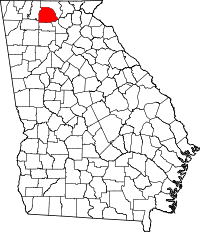East Ellijay, Georgia
| East Ellijay, Georgia | |
|---|---|
| City | |
|
East Ellijay city hall | |
 Location in Gilmer County and the state of Georgia | |
| Coordinates: 34°41′5″N 84°28′21″W / 34.68472°N 84.47250°WCoordinates: 34°41′5″N 84°28′21″W / 34.68472°N 84.47250°W | |
| Country | United States |
| State | Georgia |
| County | Gilmer |
| Area | |
| • Total | 2 sq mi (5.1 km2) |
| • Land | 2 sq mi (5.1 km2) |
| • Water | 0 sq mi (0 km2) |
| Elevation | 1,273 ft (388 m) |
| Population (2010) | |
| • Total | 546 |
| • Density | 353.5/sq mi (138.6/km2) |
| Time zone | Eastern (EST) (UTC-5) |
| • Summer (DST) | EDT (UTC-4) |
| ZIP codes | 30539-30540 |
| Area code(s) | 706/762 |
| FIPS code | 13-25356[1] |
| GNIS feature ID | 0331619[2] |
East Ellijay is a city in Gilmer County, Georgia, United States. The population was 546 at the 2010 census, down from 707 in 2000.
As its name suggests, it is just east of Ellijay, Georgia, the site of a Cherokee settlement, one of several with the name. In Cherokee the name is properly rendered "Elatseyi" (abbreviated to "Elatse"), which can be translated as "green verdant earth", suggesting fresh-springing vegetation. It was variously spelled Ellijay, Elejoy, and Allagae. In addition to the Cherokee town in Georgia, there were Cherokee towns of this name on, one, the Keowee River in South Carolina, two, on the Little Tennessee River at Ellijay Creek, and three, on Ellejoy Creek of the Little River near present-day Maryville, Tennessee.
East Ellijay was originally the location of Fort Hetzel, one of the Cherokee removal forts built in 1838 to house the Cherokee people before sending them on the "Trail of Tears".
Geography
East Ellijay is located at 34°41′5″N 84°28′21″W / 34.68472°N 84.47250°W (34.684668, -84.472434).[3]
According to the United States Census Bureau, the city has a total area of 2.0 square miles (5.2 km2), all of it land.
The town lies on the southern border of the Chattahoochee National Forest.
Demographics
| Historical population | |||
|---|---|---|---|
| Census | Pop. | %± | |
| 1910 | 291 | — | |
| 1920 | 285 | −2.1% | |
| 1930 | 298 | 4.6% | |
| 1940 | 460 | 54.4% | |
| 1950 | 549 | 19.3% | |
| 1960 | 501 | −8.7% | |
| 1970 | 488 | −2.6% | |
| 1980 | 469 | −3.9% | |
| 1990 | 303 | −35.4% | |
| 2000 | 707 | 133.3% | |
| 2010 | 546 | −22.8% | |
| Est. 2014 | 549 | [4] | 0.5% |
At the 2000 census,[1] there were 707 people, 251 households and 159 families residing in the city. The population density was 357.6 per square mile (137.9/km²). There were 265 housing units at an average density of 134.0 per square mile (51.7/km²). The racial makeup of the city was 68.60% White, 2.26% Native American, 2.97% Pacific Islander, 22.35% from other races, and 3.82% from two or more races. Hispanic or Latino of any race were 33.38% of the population.
There were 251 households of which 31.1% had children under the age of 18 living with them, 43.0% were married couples living together, 11.6% had a female householder with no husband present, and 36.3% were non-families. 28.3% of all households were made up of individuals and 15.1% had someone living alone who was 65 years of age or older. The average household size was 2.82 and the average family size was 3.18.
Age distribution was 24.5% under the age of 18, 16.0% from 18 to 24, 29.6% from 25 to 44, 17.3% from 45 to 64, and 12.7% who were 65 years of age or older. The median age was 30 years. For every 100 females there were 120.9 males. For every 100 females age 18 and over, there were 127.2 males.
The median household income was $35,875, and the median family income was $38,594. Males had a median income of $20,341 versus $20,000 for females. The per capita income for the city was $13,934. About 14.6% of families and 19.5% of the population were below the poverty line, including 16.8% of those under age 18 and 15.9% of those age 65 or over.
References
- 1 2 "American FactFinder". United States Census Bureau. Retrieved 2008-01-31.
- ↑ "US Board on Geographic Names". United States Geological Survey. 2007-10-25. Retrieved 2008-01-31.
- ↑ "US Gazetteer files: 2010, 2000, and 1990". United States Census Bureau. 2011-02-12. Retrieved 2011-04-23.
- ↑ "Annual Estimates of the Resident Population for Incorporated Places: April 1, 2010 to July 1, 2014". Retrieved June 4, 2015.
- ↑ "Census of Population and Housing". Census.gov. Retrieved June 4, 2015.
- Mooney, James. "Myths of the Cherokee" (1900, reprint 1995).
External links
| |||||||||||||||||||||
